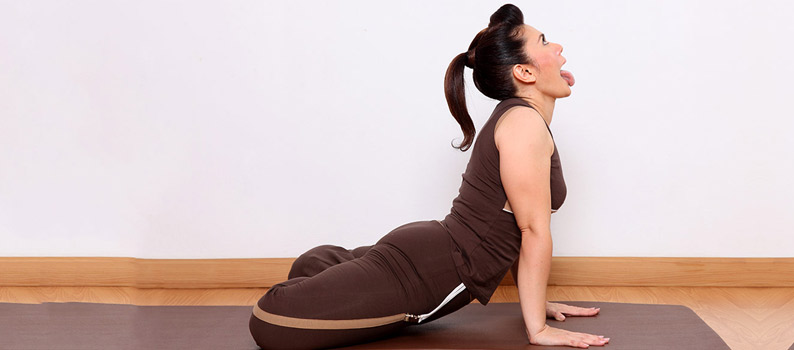Simhasana

In the Sanskrit language, Simha stands for lion, and the Simhasana translates into the Lion Pose. While practicing this asana, the final position requires practitioners to assume a position that closely resembles a squatting lion. Simhasana is considered as one of the easier asanas in the Yoga community, and can be practiced by both novices and veterans.
How to Go About It
- The first step would be to sit in the Vajrasana, or the Diamond or Thunderbolt Pose. The only minor difference to the Vajrasana would be the distance that is required to be kept between the knees.
- Your palms should be tucked under the thighs, facing down and pointing towards your own body.
- Bend a bit in the forward direction, slowly shifting the weight of your body onto your arms.
- Give your head a backward tilt, and keep your eyes open.
- With an open mouth, draw your tongue as much as you can in a forward but downward direction.
- Once this position is attained, breathe deeply, and during exhalation, make an ‘ahhh..’ sound. This is done to imitate a lion while the animal breathes with his tongue outside.
- Maintain the position as long as comfortably possible.
The Benefits
- A lot of vocal problems are eradicated through regular and devoted practice of this asana.
- People suffering from halitosis or bad breath have reported improvements.
- Tension in the face and chest is drastically reduced, leading to a healthier overall appearance.
- ‘GherandaSamita’, a famed Yogic text has referred to the asana as one which is capable of destroying every disease.
Safety Measures
As the Simhasana is one of the easiest asanas, it generally does not have any require any sort of precautionary measure. However, if you suffer from any existing physical condition, you should seek permission for practice from an expert.
Explore about the Yoga
Classifications of Yoga
- Karma Yoga
- Jnana Yoga
- Bhakti Yoga
- Kriya Yoga
- Asanas / Postures
- ARDHACAKRASANA
- BHUJANGASANA
- CHACKRASANA
- DHANURASANA
- View More
- Different forms of Yoga
- Hatha Yoga
- Kundalini Yoga
- Bhakti Yoga
- Karma Yoga
- View More
- Pranayama
- Suryabhedan
- Ujjayi
- Sheetali
- Sheetkari
- View More
- UN Declaration of Yoga Day
- Objectives of World Yoga Day
- Controversy on Yoga day
- Logo of Internation Yoga Day
- Fundamentals of Yoga
- Hand Mudra
- Yoga Day Messages
- Yoga Day SMS
- Yoga Day What's App Messages
- Yoga Day Essay
- Yoga Day Speech
- When is Yoga Day
- Yoga Day Quotes
- Yoga Day Poems
- Benefits of Yoga
- Slogans on Yoga
- Yoga Day Clipart
- Yoga Day Images
- Articles
- A Way Celebrating Your Health
- 10 Extraordinary benefits of Yoga
